Göteborg & the Volvo Ocean Race Challenge!
 Time for another tale of Magellan's travels, this time to Göteborg for the grand finish of the round-the-world Volvo Ocean Race and, as you might have anticipated, to examine Göteborg's floating maritime heritage collection.
Time for another tale of Magellan's travels, this time to Göteborg for the grand finish of the round-the-world Volvo Ocean Race and, as you might have anticipated, to examine Göteborg's floating maritime heritage collection.  The Volvo Ocean Race staring gun went off over eight months earlier in Vigo, Spain.
The Volvo Ocean Race staring gun went off over eight months earlier in Vigo, Spain. Since then, the fleet of multi-million dollar, 70 foot, ocean racing yachts had slogged through a 31,000 nautical mile race course circling the globe.
Since then, the fleet of multi-million dollar, 70 foot, ocean racing yachts had slogged through a 31,000 nautical mile race course circling the globe.  The race was started in 1972 as the famous Whitbread Race, an endurance competition to be held every four years giving the most elite ocean racing sailboats and crews a chance to prove their metal in a brutal around-the-world race for glory.
The race was started in 1972 as the famous Whitbread Race, an endurance competition to be held every four years giving the most elite ocean racing sailboats and crews a chance to prove their metal in a brutal around-the-world race for glory.  In recent years it has been going through something of an identity change being renamed the Volvo Ocean Race in 2001 (must have been a lot of money involved in that switch--'Whitbread' was a household name) and the 2005-2006 race was the first to break the convention of starting the race in the UK.
In recent years it has been going through something of an identity change being renamed the Volvo Ocean Race in 2001 (must have been a lot of money involved in that switch--'Whitbread' was a household name) and the 2005-2006 race was the first to break the convention of starting the race in the UK.  Yet the competitors have been remarkably consistent--all intense, hardcore racers. At no time during the multi-month race was the sailing the calm, relaxing sort of boating most of us are familiar with.
Yet the competitors have been remarkably consistent--all intense, hardcore racers. At no time during the multi-month race was the sailing the calm, relaxing sort of boating most of us are familiar with. 
Speed is King; Nothing else is so important in this race. Any failure to diligently squeeze every fraction of a knot out of the boat can really add up on 6,000 mile leg of the race and put a boat far behind. Thus crew comforts and even structural integrity of the vessel are often mere footnotes in decision making. At peak performance, these boats can hit 38-40 knots!
And generally, the worse the weather, the faster they go. It is undoubtedly among the longest and wildest rides you can find; 8 seconds on a bucking bronco, 8 months on a VOR 70'.
 Between each of the 9 legs of the race, when they reach port, the action carries on. The race continues--partly for reasons of sponsorship, partly for reasons of addictive racing personalities. At each of the stops they raise sail and hold an in-harbor race similar in character to the America's Cup just in case the preceding grueling passage wasn't enough sailing.
Between each of the 9 legs of the race, when they reach port, the action carries on. The race continues--partly for reasons of sponsorship, partly for reasons of addictive racing personalities. At each of the stops they raise sail and hold an in-harbor race similar in character to the America's Cup just in case the preceding grueling passage wasn't enough sailing. 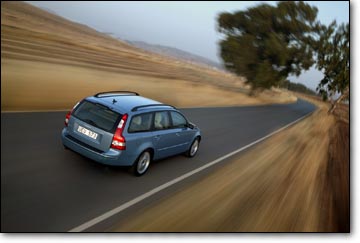 With tension over the race's finish, curiosity about Göteborg, and my own research needs all rising simultaneously, a fellow Fulbrighter, Cameron, and I rented a sporty, little, silver, Volvo stationwagon and went for a whirlwind roadtrip tour to Göteborg.
With tension over the race's finish, curiosity about Göteborg, and my own research needs all rising simultaneously, a fellow Fulbrighter, Cameron, and I rented a sporty, little, silver, Volvo stationwagon and went for a whirlwind roadtrip tour to Göteborg.  To make use of the cheap weekend rental deals, we took off early on Saturday morning...too early...and rocketed through the six-hour drive across Sweden to the west coast. When we got to Göteborg in the early afternoon, the first finishers had already been picked up by an enthusiastic welcome fleet in the Danish Straits.
To make use of the cheap weekend rental deals, we took off early on Saturday morning...too early...and rocketed through the six-hour drive across Sweden to the west coast. When we got to Göteborg in the early afternoon, the first finishers had already been picked up by an enthusiastic welcome fleet in the Danish Straits. We ditched the car and hurried for the harbor. The waterfront was jammed with people awaiting the racers. Huge television screens had been set up all along the harborfront showing live footage of the boats coming in.
We ditched the car and hurried for the harbor. The waterfront was jammed with people awaiting the racers. Huge television screens had been set up all along the harborfront showing live footage of the boats coming in. The race officials would later release figures citing some 3,000 yachts that went out to greet the VOR 70s as they came sailing in. It was amazing. I watched the big, white ferry pictured above as it was delayed almost an hour by the swarm of yachts that followed the racers in, clogging the harbor. The ferry's captain, anxious to get underway for Denmark, blew the 'five shorts' danger signal on the ship's air horns almost continuously for the full hour--to no effect.
The race officials would later release figures citing some 3,000 yachts that went out to greet the VOR 70s as they came sailing in. It was amazing. I watched the big, white ferry pictured above as it was delayed almost an hour by the swarm of yachts that followed the racers in, clogging the harbor. The ferry's captain, anxious to get underway for Denmark, blew the 'five shorts' danger signal on the ship's air horns almost continuously for the full hour--to no effect.
Along Göteborg's waterfront, more than 300,000 spectators had gathered for the big finish. It was spectacular to be in a city and a country that got so excited about sailing. You would never see this in the US. Ships and their vital role in the world are just not recognized in America. Sweden, however, has a long history and firmly based identity as a maritime nation, an identity that lends so much richness to the culture and a publicly-oriented future to maritime activity.
 When Cameron and I finally muscled ourselves through the crowd to the pierside, the lead boat was still coming up the channel. It was easy to spot where they were; all harbor traffic was headed straight for them and a group of helicopters circled low over their mastheads, broadcasting the minute-by-minute. This lovely old schooner was churning up quite a wake to get down-channel and into the thick of it.
When Cameron and I finally muscled ourselves through the crowd to the pierside, the lead boat was still coming up the channel. It was easy to spot where they were; all harbor traffic was headed straight for them and a group of helicopters circled low over their mastheads, broadcasting the minute-by-minute. This lovely old schooner was churning up quite a wake to get down-channel and into the thick of it. Soon the leader of Leg 9 came up the channel...
Soon the leader of Leg 9 came up the channel...  ...the Black Pearl, obviously primarily sponsored as a floating movie poster for Pirates of the Caribbean II.
...the Black Pearl, obviously primarily sponsored as a floating movie poster for Pirates of the Caribbean II.  In the calm waters and light winds of the harbor with all her paintwork touched up during the stop-over in Rotterdam, it was difficult to picture what kind of hell this boat had been through, tearing over rough seas of Cape Horn, the Indian Ocean, and the North Sea.
In the calm waters and light winds of the harbor with all her paintwork touched up during the stop-over in Rotterdam, it was difficult to picture what kind of hell this boat had been through, tearing over rough seas of Cape Horn, the Indian Ocean, and the North Sea.  Close on her stern came the swarm of cheering spectators on their boats. Everything was there; little plastic water ski boats, historic schooners,...
Close on her stern came the swarm of cheering spectators on their boats. Everything was there; little plastic water ski boats, historic schooners,...  ...even former racing boats now sliding into obsolescence as newer, faster designs built in composite materials take to the water.
...even former racing boats now sliding into obsolescence as newer, faster designs built in composite materials take to the water.  As the Black Pearl began to drop sail and move in towards the dock, the enthusiastic crowd swarmed around her. Boats were still pouring in from the harbor entrance, trying to catch up (the speedy race boats left many of their fans behind coming up the channel). The flotilla grew thicker and thicker, blockading the ferries to Denmark and virtually shutting down the harbor.
As the Black Pearl began to drop sail and move in towards the dock, the enthusiastic crowd swarmed around her. Boats were still pouring in from the harbor entrance, trying to catch up (the speedy race boats left many of their fans behind coming up the channel). The flotilla grew thicker and thicker, blockading the ferries to Denmark and virtually shutting down the harbor. In time, Black Pearl finally docked in a quiet 'officials only' area and the crew came up to the stage for a finish speach. The great race was finally over. They had won Leg 9... but not the entire race.
In time, Black Pearl finally docked in a quiet 'officials only' area and the crew came up to the stage for a finish speach. The great race was finally over. They had won Leg 9... but not the entire race. 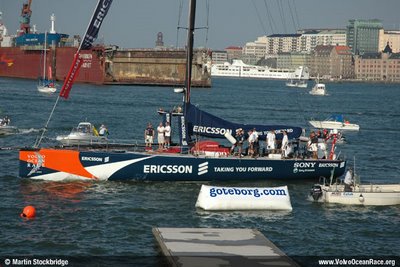 Likewise, Sony-Ericsson's boat which came in shortly after, was also not the winner.
Likewise, Sony-Ericsson's boat which came in shortly after, was also not the winner. Before long, the whole fleet was in--Pirates of the Caribbean of the US (or Disneyland), ABN AMRO I and ABN AMRO II of the Netherlands, Movistar of Spain, Brasil I of...Brazil, Ericsson Racing Team of Sweden, and Brunel of Australia--and the scores were tallied and presented (though everyone figured it out ahead of time).
Before long, the whole fleet was in--Pirates of the Caribbean of the US (or Disneyland), ABN AMRO I and ABN AMRO II of the Netherlands, Movistar of Spain, Brasil I of...Brazil, Ericsson Racing Team of Sweden, and Brunel of Australia--and the scores were tallied and presented (though everyone figured it out ahead of time). The clear winner was the ABN AMRO I and after 8 months at sea fighting for the title, quite naturally, they celebrated.
The clear winner was the ABN AMRO I and after 8 months at sea fighting for the title, quite naturally, they celebrated. The ceremony being over (but the victory party just beginning), Cameron and I boarded an overloaded harbor ferry and hopped across the channel to the historic district, the heart of Göteborg.
The ceremony being over (but the victory party just beginning), Cameron and I boarded an overloaded harbor ferry and hopped across the channel to the historic district, the heart of Göteborg. Pulling out from the dock we rounded Göteborg's iconic floating dry docks...
Pulling out from the dock we rounded Göteborg's iconic floating dry docks...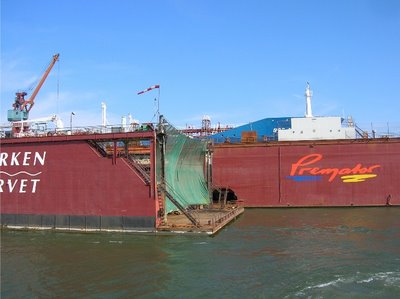
 ...and the tankers currently hauled out for maintenance.
...and the tankers currently hauled out for maintenance.

...cruised past some of the big shipyards with their towering cranes....
 ...and got a good luck down the channel at the Göteborg waterway. By then the crowd was thinning considerably--and none too soon. Note the cruiseship coming up the channel beside the Ericsberg crane.
...and got a good luck down the channel at the Göteborg waterway. By then the crowd was thinning considerably--and none too soon. Note the cruiseship coming up the channel beside the Ericsberg crane.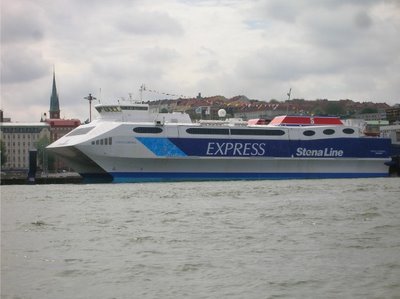 We passed the high-speed car ferry to Göteborg that I took months earlier en route to Denmark....
We passed the high-speed car ferry to Göteborg that I took months earlier en route to Denmark.... ...--ugly bugger--...
...--ugly bugger--... ...and the former training ship, Viking--lovely bugger. Like the similar af Chapman in Stockholm, she too is now a floating hostel/hotel.
...and the former training ship, Viking--lovely bugger. Like the similar af Chapman in Stockholm, she too is now a floating hostel/hotel. She was quite a sight and all decked out for the big day.
She was quite a sight and all decked out for the big day. As exciting as the aluminum and carbon-fiber race boats were, I still prefered this side of Göteborg harbor where the stately old steamers, barques, and other historic vessels were gathered.
As exciting as the aluminum and carbon-fiber race boats were, I still prefered this side of Göteborg harbor where the stately old steamers, barques, and other historic vessels were gathered. Once ashore we found that there was even more reason for celebration in Göteborg. After four years, a new sunken highway and tunnel under the city had just been opened that was supposed to relieve trafffic congestion (hear that Boston? 4 years. That's right, only 4). I thought about joining the road-race through the tunnel, but...well...I didn't.
Once ashore we found that there was even more reason for celebration in Göteborg. After four years, a new sunken highway and tunnel under the city had just been opened that was supposed to relieve trafffic congestion (hear that Boston? 4 years. That's right, only 4). I thought about joining the road-race through the tunnel, but...well...I didn't. Besides, I was just getting to my research material, a fleet of historic vessels moored together along the waterfront as a floating museum that I had been researching.
Besides, I was just getting to my research material, a fleet of historic vessels moored together along the waterfront as a floating museum that I had been researching.  Maritiman Maritime Center has a very diverse collection of 19 historic vessels on display--more than any other comparable maritime center in the world--or so they claim.
Maritiman Maritime Center has a very diverse collection of 19 historic vessels on display--more than any other comparable maritime center in the world--or so they claim. 
They certainly have some spectacularly maintained and pretty unique items moored there. This is lightship No. 29...
 She was stationed on a treacherous spot named Fladen--I believe it is a shoal in the Danish Straits along the Swedish coast.
She was stationed on a treacherous spot named Fladen--I believe it is a shoal in the Danish Straits along the Swedish coast. Maritiman also has a beautiful old coastal freighter--a huge undertaking for a small museum. It is a lot of tonnage and paint to maintain for a limited amount of visitor appreciation. I mean, the average visitor usually just isn't all that interested by an empty box of a cargo ship. It does not matter if the ship was a vital pillar of the region's maritime history, it has to to have general appeal in order to 'reach' the visitor and thereby accomplish the museum's ultimate aim of preserving knowledge of maritime heritage for/within the public. General appeal is important--and probably part of why Maritiman acquired a destroyer and flock or torpedo and mine-laying boats.
Maritiman also has a beautiful old coastal freighter--a huge undertaking for a small museum. It is a lot of tonnage and paint to maintain for a limited amount of visitor appreciation. I mean, the average visitor usually just isn't all that interested by an empty box of a cargo ship. It does not matter if the ship was a vital pillar of the region's maritime history, it has to to have general appeal in order to 'reach' the visitor and thereby accomplish the museum's ultimate aim of preserving knowledge of maritime heritage for/within the public. General appeal is important--and probably part of why Maritiman acquired a destroyer and flock or torpedo and mine-laying boats. Yet I admire Maritiman for tackling this challenge--the challenge of caring for a vessel of high historical importance and high maintenance costs, but relatively low visitor appeal. How do they present the ship and her history so as to justify her preservation withthe general public? That is a challenge that requires a skilled exhibitons and programming staff that can 'make her interesting' (you have no idea how grating it is for me to write that. I find her infinitely interesting... but I know I am unusual. After all, I was studying steam boiler design until 3am this morning--for fun) Ships like this are the same problem maritime museums face with fishing boats--how do you get people interested?
Yet I admire Maritiman for tackling this challenge--the challenge of caring for a vessel of high historical importance and high maintenance costs, but relatively low visitor appeal. How do they present the ship and her history so as to justify her preservation withthe general public? That is a challenge that requires a skilled exhibitons and programming staff that can 'make her interesting' (you have no idea how grating it is for me to write that. I find her infinitely interesting... but I know I am unusual. After all, I was studying steam boiler design until 3am this morning--for fun) Ships like this are the same problem maritime museums face with fishing boats--how do you get people interested?
Unfortunately, the old wisdom that it takes 'either a tall ship or a warship' to build a maritime museum generally holds true. Tall masts or big guns draw people's curiosity--not tall tales of fishing or big cargo holds, at least, not at first. Again, I find it comes down to the skill of exhibit designers and their presentation of the material. With the right mix of exhibit formats and content, it is possible to hook people's interest in just about anything.
 Back to our story... while I zoned out staring at the ships and asking myself museum theory questions, Cameron was facing the other direction to where a huge beer garden had been set up on the quay. This was the middle of both the World Cup and the Scandinavian summer--cause to have a beer garden and a big-screen set up outside.
Back to our story... while I zoned out staring at the ships and asking myself museum theory questions, Cameron was facing the other direction to where a huge beer garden had been set up on the quay. This was the middle of both the World Cup and the Scandinavian summer--cause to have a beer garden and a big-screen set up outside. So we sat down to watch the America vs. Italy game. Cameron was focused on the game, frequently shaking his head mournfully at pathetic failures to score a goal while I remained transfixed on the fleet tied up beside us. The destroyer is pretty obvious in this shot--as is Cameron's disappointment.
So we sat down to watch the America vs. Italy game. Cameron was focused on the game, frequently shaking his head mournfully at pathetic failures to score a goal while I remained transfixed on the fleet tied up beside us. The destroyer is pretty obvious in this shot--as is Cameron's disappointment. It was an alright game I suppose--but how would I know? I played the sport for one season when I was 8---and everyone else seemed to be satisfied. Somewhere in the second half Cameron thought I was finally beginning to get into the game, but actually my aviation interests had kicked in at the sight of a hot air balloon floating behind the screen.
It was an alright game I suppose--but how would I know? I played the sport for one season when I was 8---and everyone else seemed to be satisfied. Somewhere in the second half Cameron thought I was finally beginning to get into the game, but actually my aviation interests had kicked in at the sight of a hot air balloon floating behind the screen. 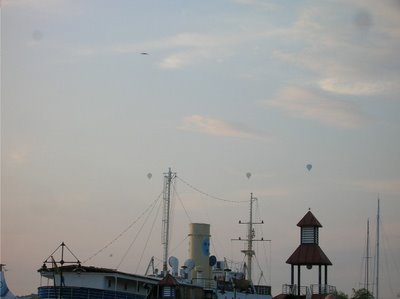 There was a whole fleet of them drifting over the city just as they do in Stockholm. They are popular here...must be because it is so hard to get a pilot's license for a small plane. Maybe the paperwork for balloons is easier.
There was a whole fleet of them drifting over the city just as they do in Stockholm. They are popular here...must be because it is so hard to get a pilot's license for a small plane. Maybe the paperwork for balloons is easier. Honestly, I missed the end of the game. I was back over the quayside studying the arrangement of the museum ships. What a hodge-podge! But clearly, whatever they were doing was working. All the boats were beautifully kept up, even Gunhild the little fishing boat.
Honestly, I missed the end of the game. I was back over the quayside studying the arrangement of the museum ships. What a hodge-podge! But clearly, whatever they were doing was working. All the boats were beautifully kept up, even Gunhild the little fishing boat. Perhaps the most interesting vessel in their collection was the Sölve, a denuded, iron, monitor--apparently the last in existence. Inspired by the legendary USS Monitor of the American Civil War, she was built a decade later in 1875 and spent more than a lifetime in miltary service and then as an oil barge. Eventually, she made her way here for partial restoration (no turret, stack, or guns).
Perhaps the most interesting vessel in their collection was the Sölve, a denuded, iron, monitor--apparently the last in existence. Inspired by the legendary USS Monitor of the American Civil War, she was built a decade later in 1875 and spent more than a lifetime in miltary service and then as an oil barge. Eventually, she made her way here for partial restoration (no turret, stack, or guns). For being from the first generation of ironclads, she's remarkably graceful and well-preserved. Yet, in her form it is possible to see the logic of the time--armor and being as low and flat as possible (with no engine or fuel she's floating high now), not presenting a target any more than absolutely necessary. Even her rudder--a favorite target in naval battles--is safely encased within the hull form.
For being from the first generation of ironclads, she's remarkably graceful and well-preserved. Yet, in her form it is possible to see the logic of the time--armor and being as low and flat as possible (with no engine or fuel she's floating high now), not presenting a target any more than absolutely necessary. Even her rudder--a favorite target in naval battles--is safely encased within the hull form. Just up the quay from her is the little tug Herkules and a barge made into a floating bar that sits right smack inthe middle of the museum collection. That raised a whole string of ethical, legal, reputational, and financial questions for me. Meeting the director would be interesting, no doubt.
Just up the quay from her is the little tug Herkules and a barge made into a floating bar that sits right smack inthe middle of the museum collection. That raised a whole string of ethical, legal, reputational, and financial questions for me. Meeting the director would be interesting, no doubt. On the other side of the tug, the bar, and a torpedo-boat lay the destroyer Småland, purportedly the largest museum ship in Scandinavia and the first ship to carry missiles (See, Sweden may be peaceful but it has always been armed to the teeth).
On the other side of the tug, the bar, and a torpedo-boat lay the destroyer Småland, purportedly the largest museum ship in Scandinavia and the first ship to carry missiles (See, Sweden may be peaceful but it has always been armed to the teeth). Maritiman also had some guest moorage--a more and more common feature at maritime museums. It brings in extra revenue, reinforces relations with the yachting community, and
Maritiman also had some guest moorage--a more and more common feature at maritime museums. It brings in extra revenue, reinforces relations with the yachting community, andoccasionally people sail in with 'free, temporary, exhibits', a.k.a. intersting or beautiful boats. At Mystic Seaport, a few of the prettier old ones have almost become permanent residents.
 The game being over, and darkness falling--remember, this was June when it nerve really gets entirely dark at this latitude--we decided to head for the home of a fellow Fulbrighter living in Göteborg, arriving htere sometime around midnight.
The game being over, and darkness falling--remember, this was June when it nerve really gets entirely dark at this latitude--we decided to head for the home of a fellow Fulbrighter living in Göteborg, arriving htere sometime around midnight. The next morning, Cameron and I were back in the city and decided to go for a tourist dive on the highly-recommended Paddan boat tours. The Paddan boats were essentially big steel motorbarges with plastic seats and a pair of undersized outboard motors.
The next morning, Cameron and I were back in the city and decided to go for a tourist dive on the highly-recommended Paddan boat tours. The Paddan boats were essentially big steel motorbarges with plastic seats and a pair of undersized outboard motors. They take you through the city's old canals...
They take you through the city's old canals...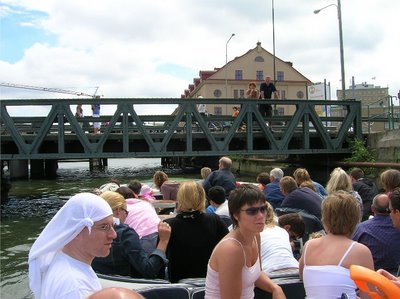 ...weaving and winding thorough the historic district and slipping under some 21 bridges.
...weaving and winding thorough the historic district and slipping under some 21 bridges.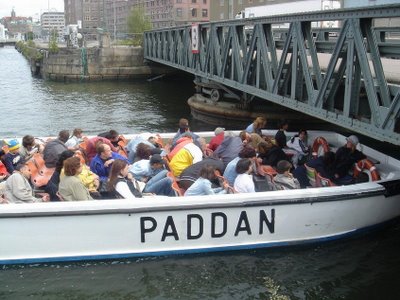 The lowest of them was known as the cheese-slicer...
The lowest of them was known as the cheese-slicer... ...and crouching down to clear it, it certainly gave that impression.
...and crouching down to clear it, it certainly gave that impression. Most of the tourguide's information was fairly dull--anecdotes about famous personages that lived within three blocks of the canal--but we did pass the old Swedish East India Company building (you can see the name written in the frieze).
Most of the tourguide's information was fairly dull--anecdotes about famous personages that lived within three blocks of the canal--but we did pass the old Swedish East India Company building (you can see the name written in the frieze).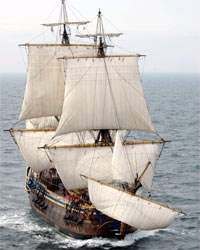 It was the Ostindiskkompaniet (East India Comapany) that built and sailed the East Indiamen to the East Indies (does this sound repetitive or what?).
It was the Ostindiskkompaniet (East India Comapany) that built and sailed the East Indiamen to the East Indies (does this sound repetitive or what?).
In fact, the Götheborg III (old spelling with an 'h') that was just built in Göteborg and has recently arrived in Shanghai, China after a 10 month voyage, is a copy of an East Indiaman built and operated by Ostindiskakompaniet that sank outside Göteborg harbor in the 1700s.
 Under one more 'cheese slicer' and popped out of the canals onto the open harbor.
Under one more 'cheese slicer' and popped out of the canals onto the open harbor. Instantly I was much happier--big water and big ships. We chugged up the waterfront right past the Maritiman maritime center...
Instantly I was much happier--big water and big ships. We chugged up the waterfront right past the Maritiman maritime center...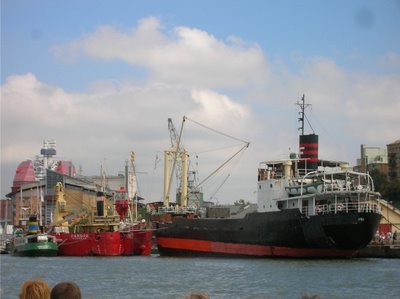 .... affording me a good look at the old freighter--floating very high in the water...
.... affording me a good look at the old freighter--floating very high in the water... ...and demonstrating that the museum's painting maintenance is done in a piece-meal manner.
...and demonstrating that the museum's painting maintenance is done in a piece-meal manner. Then we came abeam of the destroyer Småland, bristling like a veritable Bofors showroom.
Then we came abeam of the destroyer Småland, bristling like a veritable Bofors showroom.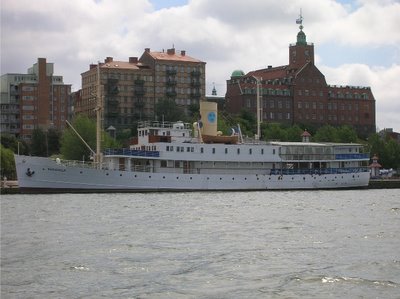 ...and a former royal yacht recently added to the collection.
...and a former royal yacht recently added to the collection. It was also good just to see the colleciton as a whole from the waterside--good for wrapping it up for contemplation.
It was also good just to see the colleciton as a whole from the waterside--good for wrapping it up for contemplation. Then my contented reflection was shattered by a hideous barge converted into a floating parking garage...but it was a good idea for the overcrowded downtown area.
Then my contented reflection was shattered by a hideous barge converted into a floating parking garage...but it was a good idea for the overcrowded downtown area. Moored alongside the opera house was a beautiful wooden ketch...
Moored alongside the opera house was a beautiful wooden ketch... ...and just a little further along, we puttered past the impressive Viking again.
...and just a little further along, we puttered past the impressive Viking again. There were interesting craft all over the place...
There were interesting craft all over the place... ...a lovely Colin Archer yawl plowing past...
...a lovely Colin Archer yawl plowing past...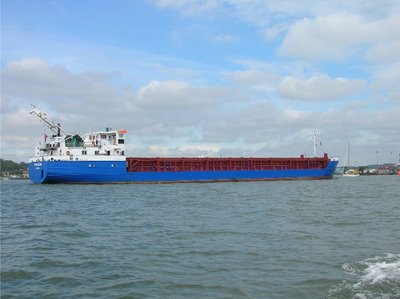 ...and a coastal freighter coming up the channel.
...and a coastal freighter coming up the channel. She was probably heading for the Göte River and then on up the Göta Kanal for a cargo of grain, iron ore, lumber, or some other bulk cargo.
She was probably heading for the Göte River and then on up the Göta Kanal for a cargo of grain, iron ore, lumber, or some other bulk cargo. Her crew was out on the rail (with cameras no less) enjoyin gthe summer weather and the scenic passage through Göteborg and on inland.
Her crew was out on the rail (with cameras no less) enjoyin gthe summer weather and the scenic passage through Göteborg and on inland. The mast had already been folded back in preparation for all the bridges, some of which were barely wide enough for her to fit through.
The mast had already been folded back in preparation for all the bridges, some of which were barely wide enough for her to fit through. Crossing her stern to the other side ofthe channel, the little Paddan tourboat took us back down stream along the dockyards, some of the last big shipyards still going in Göteborg.
Crossing her stern to the other side ofthe channel, the little Paddan tourboat took us back down stream along the dockyards, some of the last big shipyards still going in Göteborg. These few were the lsat survivors, but they were proud of it and showed every indication of intending to remain in the fight to stay in business.
These few were the lsat survivors, but they were proud of it and showed every indication of intending to remain in the fight to stay in business. These docks under the massive shipyard cranes were empty today, but as you may recall from the "Passage to Denmark" posting, these docks were handling repairs for some of the biggest ships in Swedish waters--at that time it was the Wallenius Line automobile carrier Madame Butterfly.
These docks under the massive shipyard cranes were empty today, but as you may recall from the "Passage to Denmark" posting, these docks were handling repairs for some of the biggest ships in Swedish waters--at that time it was the Wallenius Line automobile carrier Madame Butterfly. Then we bore down on the floating drydocks again, chock-full of mid-size oil tankers.
Then we bore down on the floating drydocks again, chock-full of mid-size oil tankers.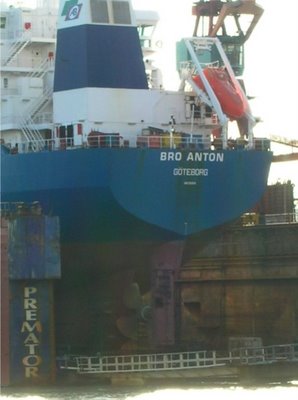
Here, a 'local gal' has been hauled out for some maintenance. She displays the modern 'bobsled' lifeboat launching system, but the now frowned-upon single screw and rudder that if disabled, have no back-up as we saw on the Stena Primorsk. These dockyards sure know how to make you feel insignificant, towering over us in those little frying pan Paddan motorbarges.
These dockyards sure know how to make you feel insignificant, towering over us in those little frying pan Paddan motorbarges. But it is wonderful to find such thriving maritime activity right on the central waterfront of one of the world's major cities.
But it is wonderful to find such thriving maritime activity right on the central waterfront of one of the world's major cities.
 This is no small ship.
This is no small ship. We also passed the merchant seamans' emergency training facility, a high platform cluttered with examples of just about every lifeboat and liferaft launching system in use. A precious facility for sailors that might find themselves in one of the all too often unpublicized maritime disasters.
We also passed the merchant seamans' emergency training facility, a high platform cluttered with examples of just about every lifeboat and liferaft launching system in use. A precious facility for sailors that might find themselves in one of the all too often unpublicized maritime disasters. Back ashore, Cameron and I wandered up the shore, passing a few more lovely hulls, and then headed for the car. It was time to get back on the road.
Back ashore, Cameron and I wandered up the shore, passing a few more lovely hulls, and then headed for the car. It was time to get back on the road. We hit the World Cultures Museum on the way out of town. It was well done, but it had this one exhibit that looked like an incarnation of a National Geographic article.
We hit the World Cultures Museum on the way out of town. It was well done, but it had this one exhibit that looked like an incarnation of a National Geographic article. We also paused along the outer coast so we could have a look at the open water...
We also paused along the outer coast so we could have a look at the open water... ...and the Kungälv fortress.
...and the Kungälv fortress. Then, 6 hours and several hundred kilometers later, we arrived back in Stockholm. The long sub-artic day was drawing to a close as we blew through town in the late evening, rushing into heavy traffic in our hurry to return the car before we had to pay for another day.
Then, 6 hours and several hundred kilometers later, we arrived back in Stockholm. The long sub-artic day was drawing to a close as we blew through town in the late evening, rushing into heavy traffic in our hurry to return the car before we had to pay for another day. By the time we had made it to the airport, returned the car, and then made our way back, the lone hour of true night Stockholm experiences in June had arrived. Unfortunately, at that hour on a Sunday night-Monday morning, all the ferries and busses are shut down.
By the time we had made it to the airport, returned the car, and then made our way back, the lone hour of true night Stockholm experiences in June had arrived. Unfortunately, at that hour on a Sunday night-Monday morning, all the ferries and busses are shut down.
Rats!
So, another classic Magellan journey began, walking miles and mile sin the dark, searching for my way home. It was just like the time I got left behind and eventually hopelessly lost in Wisconsin's huge Kettle Morraine Park or the time I found myself trudging my way across Nantucket in the dead of night searching for a phantom field station.... Yet, it was a nice night and although I spent wo hours hiking home, it was enjoyable under the stars and moon...
Yet, it was a nice night and although I spent wo hours hiking home, it was enjoyable under the stars and moon... ...and it was not long at all before the mid summer sky began to lighten. It was actually a great walk....until I was attacked by a group of seagulls defending a nest....
...and it was not long at all before the mid summer sky began to lighten. It was actually a great walk....until I was attacked by a group of seagulls defending a nest....
...but somehow, that was the perfect end to a whirlwind roadtrip to Göteborg to see the end of the Volvo Ocean Race and look at another maritime museum.
Labels: Bro Anton, Göteborg, Kungälv, Maritiman, Volvo Ocean Race, Windstar


0 Comments:
Post a Comment
<< Home